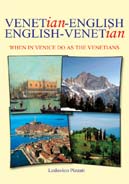Edision a stanpa de "el Galepin"
|
Da 'l nòstro galepin podemo ricavar version difarente da réndar disponìbiƚe anca in edision stanpàe: multilengua, de àrea spesìfega (i coƚori de ƚa nòstra mapa), de uxo particoƚar (mistièri e profesion, nòmi de spèce vegetaƚe o animaƚe ect...), co' o sensa sinònimi e incontrari, co' o sensa fraxe de uxo tìpico, co' o sensa estrati de literadura, pì o manco estexe (baxe/esensial, marelengua, profondo). El total de i dati che gavemo a despoxision el podarìa inpenir racuanti, gròsi voƚumi a stanpa...
Podemo anca tirar fora edision in grafìe difarente in pochi menuti, e mandarle in stanpa conforme preferensa de i clienti, inte i lìmiti de ƚa vèneta tradision, che ƚa xé fonèdega (i estrati de letradura i rèsta in grafìa orixenal). Ƚa corispondensa fonèdega ƚa xé anca necesariamente baxe par cualsesipia bon gaƚepin (in Talian prexenpio, i gaƚepini de un sèrto livèƚo uxa segnar oportunamente i èse sordi/sonòri e i zeta sordi/sonòri "s/ṡ" e "z/ż"). In Vèneto xé tradisional 'l uxo de "k" o "q"; i uxi indifarenti de "th", "ẑ" o "zh", come de "dh" o "đ"; no ghe xé distinsion né confuxion posìbiƚe fra "sci/sce" e "sči/sče"; se pol anca lejitimamente preferir un sistèma de èse intervocàƚego alternadivo "ss/s" o "s/x", ect...
Somexo alternadiva gràfega ǧenerà co' automatismo via software:
Podemo anka tirar fora edission in grafìe difarente in poki menuti, e mandarle in stanpa konforme preferensa de i klienti, inte i lìmiti de ƚa vèneta tradission, che ƚa xé fonèdega (i estrati de letradura i rèsta in grafìa orisenal). Ƚa korispondensa fonèdega ƚa xé anka nečessariamente base par kualsessipia bon gaƚepin (in Talian presenpio, i gaƚepini de bon livèƚo i usa segnar oportunamente i èsse sordi/sonòri e i zeta sordi/sonòri "s/ṡ" e "z/ż"). In Vèneto xé tradissional el uso de "k" o "q"; i usi indifarenti de "th", "ẑ" o "zh", kome de "dh" o "đ"; no ge xé distinsion né konfusion possìbiƚe fra "sci/sce" e "sči/sče"; se pol anka lejitimamente preferir un sistèma de èsse intervocàƚego alternadivo "ss/s" o "s/x", ect...
Xé stà mandà fora na version a stanpa traxesta da ƚa nòstra baxe dati a cura de Lodovico Pizzati "Vèneto-Inglexe / Inglexe-Vèneto". [exaurìo - fora catàlogo]
Altre version ƚe xé senpre potensialmente pronte in poco tenpo (2-3 mexi), previa demostrasion de intarèse da parte de i venetòfoni. Restemo a despoxision par incontentarli prontamente co' i nòstri prodoti.
 Authorhouse Authorhouse
Have you ever wondered what gondoliers speak to one another across Venetian canals? No Italian dictionary will help you decipher what they say. What they speak is not a secret code, but a language also shared by shop keepers, waiters and hotel concierges throughout Venice, as well as millions of other people in the surrounding territory. From the valleys in the Dolomites down to the Northern Adriatic shores, in cities like Verona, Vicenza, Padua, Treviso, Trieste and Venice, people speak one common mother tongue. This dictionary introduces the reader to this beautiful language once spoken by Marco Polo, Palladio, Vivaldi, Canaletto and Casanova, and now still vibrant and widely in use. With 30,000 Venet words and a corresponding 20,000 English translations, this dictionary makes this musical language, once preferred in the Renaissance for commerce, theatre and diplomacy, accessible to the world once again. Not only does this dictionary include word translations but it also offers an introductory chapter guiding the reader through historical curiosities and linguistic peculiarities. You will find that in ancient times this language was written in a distinct alphabet unlike the one used by the Greeks and the Romans. That it was used in the first neo-Latin vernacular writing in the 9th century AD, and that Galileo used it in his first assertion of the heliocentric system. You will discover what Dante really thought about it while in exile in Verona, the mythological roots in Homer’s Iliad as well as the surprising presence of this language also in Latin America, still thriving since the late 1800s.
|
